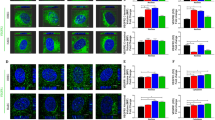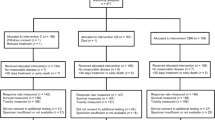Abstract
Vascular endothelial growth factor (VEGF) signaling is critical for tumor angiogenesis. However, therapies based on inhibition of VEGF receptors (VEGFRs) have shown modest results for patients with cancer. Surprisingly little is known about mechanisms underlying the regulation of VEGFR1 and VEGFR2 expression, the main targets of these drugs. Here, analysis of tissue microarrays revealed an inversely reciprocal pattern of VEGFR regulation in the endothelium of human squamous-cell carcinomas (high VEGFR1, low VEGFR2), as compared with the endothelium of control tissues (low VEGFR1, high VEGFR2). Mechanistic studies demonstrated that VEGF signals through the Akt/ERK pathway to inhibit constitutive ubiquitination and induce rapid VEGFR1 accumulation in endothelial cells. Surprisingly, VEGFR1 is primarily localized in the nucleus of endothelial cells. In contrast, VEGF signals through the JNK/c-Jun pathway to induce endocytosis, nuclear translocation, and downregulation of VEGFR2 via ubiquitination. VEGFR1 signaling is required for endothelial-cell survival, while VEGFR2 regulates capillary tube formation. Notably, the antiangiogenic effect of bevacizumab (anti-VEGF antibody) requires normalization of VEGFR1 and VEGFR2 levels in human squamous-cell carcinomas vascularized with human blood vessels in immunodeficient mice. Collectively, this work demonstrates that VEGF-induced angiogenesis requires inverse regulation of VEGFR1 and VEGFR2 in tumor-associated endothelial cells.
Similar content being viewed by others
Log in or create a free account to read this content
Gain free access to this article, as well as selected content from this journal and more on nature.com
or
Abbreviations
- VEGF:
-
vascular endothelial growth factor
- VEGFR1:
-
vascular endothelial growth factor receptor-1
- VEGFR2:
-
vascular endothelial growth factor receptor-2
- RTK:
-
receptor tyrosine kinase
- EGF:
-
epidermal growth factor
- EGFR:
-
epidermal growth factor receptor
- PlGF:
-
placental growth factor
- IL-6:
-
interleukin-6
- PI3K/Akt:
-
phosphoinositol-3-kinase/Akt
- ERK:
-
extracellular signal-regulated kinase
- JNK:
-
c-Jun N-terminal kinase
- STAT3:
-
signal transducer and activator of transcription-3
- HDMEC:
-
human dermal microvascular endothelial cell
- HPEC:
-
human pulmonary endothelial cell
- FBS:
-
fetal bovine serum
- CM:
-
conditioned medium
References
Leung DW, Cachianes G, Kuang WJ, Goeddel DV, Ferrara N . Vascular endothelial growth factor is a secreted angiogenic mitogen. Science 1989; 246: 1306–1309.
Carmeliet P . VEGF as a key mediator of angiogenesis in cancer. Oncology 2005; 69 (Suppl. 3): 4–10.
Ellis LM, Hicklin DJ . VEGF-targeted therapy: mechanisms of antitumour activity. Nat Rev Cancer 2008; 8: 579–591.
Carmeliet P, Ferreira V, Breier G, Pollefeyt S, Kieckens L, Gertsenstein M et al. Abnormal blood vessel development and lethality in embryos lacking a single VEGF allele. Nature 1996; 380: 435–439.
Ferrara N, Carver-Moore K, Chen H, Dowd M, Lu L, O'Shea KS et al. Heterozygous embryonic lethality induced by targeted inactivation of the VEGF gene. Nature 1996; 380: 439–442.
Lee S, Chen TT, Barber CL, Jordan MC, Murdock J, Desai S et al. Autocrine VEGF signaling is required for vascular homeostasis. Cell 2007; 130: 691–703.
Kerbel RS . Tumor angiogenesis. N Engl J Med 2008; 358: 2039–2049.
Hurwitz H, Fehrenbacher L, Hainsworth JD, Heim W, Berlin J, Holmgren E et al. Bevacizumab in combination with fluorouracil and leucovorin: an active regimen for first-line metastatic colorectal cancer. J Clin Oncol 2005; 23: 3502–3508.
Kerbel RS, Yu J, Tran J, Man S, Viloria-Petit A, Klement G et al. Possible mechanisms of acquired resistance to antiangiogenic drugs: implications for the use of combination therapy approaches. Cancer Metastasis Rev 2001; 20: 79–86.
Miller KD, Sweeney CJ, Sledge GW . Can tumor angiogenesis be inhibited without resistance? EXS 2005; 94: 95–112.
Casanovas O, Hicklin DJ, Bergers G, Hanahan D . Drug resistance by evasion of antiangiogenic targeting of VEGF signaling in late-stage pancreatic islet tumors. Cancer Cell 2005; 4: 299–309.
Shibuya M, Yamaguchi S, Yamane A, Ikeda T, Tojo A, Matsushime H et al. Nucleotide sequence and expression of a novel human receptor-type tyrosine kinase gene (flt) closely related to the fms family. Oncogene 1990; 5: 519–524.
Matthews W, Jordan CT, Gavin M, Jenkins NA, Copeland NG, Lemischka IR . A receptor tyrosine kinase cDNA isolated from a population of enriched primitive hematopoietic cells and exhibiting close genetic linkage to c-kit. Proc Natl Acad Sci USA 1991; 88: 9026–9030.
Olsson AK, Dimberg A, Kreuger J, Claesson-Welsh L . VEGF receptor signaling – in control of vascular function. Nat Rev Mol Cell Biol 2006; 7: 359–371.
Waltenberger J, Claesson WL, Siegbahn A, Shibuya M, Heldin CH . Different signal transduction properties of KDR and Flt1, two receptors for vascular endothelial growth factor. J Biol Chem 1994; 269: 26988–26995.
Takahashi H, Shibuya M . The vascular endothelial growth factor (VEGF)/VEGF receptor system and its role under physiological and pathological conditions. Clin Sci 2005; 109: 227–241.
Gille H, Kowalski J, Li B, LeCouter J, Moffat B, Zioncheck TF et al. Analysis of biological effects and signaling properties of Flt-1 (VEGFR-1) and KDR (VEGFR-2). A reassessment using novel receptor-specific vascular endothelial growth factor mutants. J Biol Chem 2001; 276: 3222–3230.
Huang F, Kirkpatrick D, Jiang X, Gygi S, Sorkin A . Differential regulation of EGF receptor internalization and degradation by multi-ubiquitination within the kinase domain. Mol Cell 2006; 21: 737–748.
Duval M, Bédard GS, Delisle C, Gratton JP . Vascular endothelial growth factor-dependent downregulation of Flk-1/KDR involves Cbl-mediated ubiquitination: consequences on nitric oxide production from endothelial cells. J Biol Chem 2003; 278: 20091–20097.
Ewan LC, Jopling HM, Jia H, Mittar S, Bagherzadeh A, Howell GJ et al. Intrinsic tyrosine kinase activity is required for vascular endothelial growth factor receptor 2 ubiquitination, sorting, and degradation in endothelial cells. Traffic 2006; 7: 1270–1280.
Dougher M, Terman BI . Autophosphorylation of KDR in the kinase internalization. Oncogene 1999; 18: 1619–1627.
Radhakrishnan R, Solomon M, Satyamoorthy K, Martin LE, Lingen MW . Tissue microarray – a high-throughput molecular analysis in head and neck cancer. J Oral Pathol Med 2008; 37: 166–176.
Fuchs SY, Xie B, Adler V, Fried VA, Davis RJ, Ronai Z . c-Jun NH2-terminal kinases target the ubiquitination of their associated transcription factors. J Biol Chem 1997; 272: 32163–32168.
Hibi M, Lin A, Smeal T, Minden A, Karin M . Identification of an oncoprotein- and UV-responsive protein kinase that binds and potentiates the c-jun activation domain. Genes Dev 1993; 7: 2135–2148.
Nör JE, Christensen J, Mooney DJ, Polverini PJ . Vascular endothelial growth factor-mediated angiogenesis is associated with Bcl-2 upregulation and enhanced endothelial cell survival. Am J Pathol 1999; 154: 375–384.
Yu C, Minemoto Y, Zhang J, Liu J, Tang F, Bui TN et al. JNK suppresses apoptosis via phosphorylation of the proapoptotic Bcl-2 family protein BAD. Mol Cell 2004; 13: 329–340.
Kim KW, Mutter RW, Cao C, Albert JM, Shinohara ET, Sekhar KR et al. Inhibition of signal transducer and activator of transcription 3 activity results in downregulation of survivin following irradiation. Mol Cancer Ther 2006; 5: 2659–2665.
Kitamura T, Asai N, Enomoto A, Maeda K, Kato T, Ishida M et al. Regulation of VEGF-mediated angiogenesis by the Akt/PKB substrate girdin. Nat Cell Biol 2008; 10: 329–337.
Mavria G, Vercoulen Y, Yeo M, Paterson H, Karasarides M, Marais R et al. ERK–MAPK signaling opposes Rho-kinase to promote endothelial cell survival and sprouting during angiogenesis. Cancer Cell 2006; 9: 33–44.
Hilfiker-Kleiner D, Hilfiker A, Fuchs M, Kaminski K, Schaefer A, Schieffer B et al. Signal transducer and activator of transcription 3 is required for myocardial capillary growth, control of interstitial matrix deposition, and heart protection from ischemic injury. Circ Res 2004; 95: 187–195.
Nishimura K, Li W, Hoshino Y, Kadohama T, Asada H, Ohgi S et al. Role of AKT in cyclic strain-induced endothelial cell proliferation and survival. Am J Physiol Cell Physiol 2006; 290: C812–C821.
Nör JE, Peters MC, Christensen JB, Sutorik MM, Linn S, Khan MK et al. Engineering and characterization of functional human microvessels in immunodeficient mice. Lab Invest 2001; 81: 453–463.
Kaneko T, Zhang Z, Mantellini MG, Karl E, Zeitlin B, Verhaegen M et al. Bcl-2 orchestrates a crosstalk between endothelial cells and tumor cells that promotes tumor growth. Cancer Res 2007; 67: 9685–9693.
Du R, Lu KV, Petritsch C, Liu P, Ganss R, Passegue E et al. HIF1-alpha induces the recruitment of bone marrow-derived vascular modulatory cells to regulate tumor angiogenesis and invasion. Cancer Cell 2008; 13: 206–220.
Karl E, Zhang Z, Dong Z, Neiva KG, Soengas MS, Koch AE et al. Unidirectional crosstalk between Bcl-xL and Bcl-2 enhances the angiogenic phenotype of endothelial cells. Cell Death Differ 2007; 14: 1657–1666.
Mittar S, Ulyatt C, Howell GJ, Bruns AF, Zachary I, Walker JH et al. VEGFR1 receptor tyrosine kinase localization to the Golgi apparatus is calcium-dependent. Exp Cell Res 2009; 315: 877–889.
Gerber HP, Dixit V, Ferrara N . Vascular endothelial growth factor induces expression of the antiapoptotic proteins Bcl-2 and A1 in vascular endothelial cells. J Biol Chem 1998; 273: 13313–13316.
Ferrara N, Gerber HP, LeCouter J . The biology of VEGF and its receptors. Nat Med 2003; 9: 669–676.
Shibuya M, Claesson WL . Signal transduction by VEGF receptors in regulation angiogenesis and lymphangiogenesis. Exp Cell Res 2006; 312: 549–560.
Acknowledgements
We thank Dr Zhihong Dong for assistance with the SCID Mouse Model of Human Tumor Angiogenesis, and Dr Seungwon Kim for critically reading the paper and providing invaluable suggestions. This work was supported by grant R01-CA112390 from the NIH/NCI (LME); grant R01-DE12322 from the NIH/NIDCR (MWL); grant P50-CA97248 (University of Michigan Head and Neck SPORE) from the NIH/NCI (JEN); and grants R01-DE14601, R01-DE15948, R01-DE16586, and R21-DE19279 from the NIH/NIDCR (JEN).
Author information
Authors and Affiliations
Corresponding author
Additional information
Edited by G Rabinovich
Supplementary Information accompanies the paper on Cell Death and Differentiation website (http://www.nature.com/cdd)
Supplementary information
Rights and permissions
About this article
Cite this article
Zhang, Z., Neiva, K., Lingen, M. et al. VEGF-dependent tumor angiogenesis requires inverse and reciprocal regulation of VEGFR1 and VEGFR2. Cell Death Differ 17, 499–512 (2010). https://doi.org/10.1038/cdd.2009.152
Received:
Revised:
Accepted:
Published:
Issue date:
DOI: https://doi.org/10.1038/cdd.2009.152
Keywords
This article is cited by
-
Inverse and reciprocal regulation of p53/p21 and Bmi-1 modulates vasculogenic differentiation of dental pulp stem cells
Cell Death & Disease (2021)
-
Spatial and temporal VEGF receptor intracellular trafficking in microvascular and macrovascular endothelial cells
Scientific Reports (2021)
-
Vascular endothelial growth factor receptor 2 (VEGFR2) correlates with long-term survival in patients with advanced high-grade serous ovarian cancer (HGSOC): a study from the Tumor Bank Ovarian Cancer (TOC) Consortium
Journal of Cancer Research and Clinical Oncology (2019)
-
Mechanistic insight into activation of MAPK signaling by pro-angiogenic factors
BMC Systems Biology (2018)
-
VEGFR1 promotes cell migration and proliferation through PLCγ and PI3K pathways
npj Systems Biology and Applications (2017)



